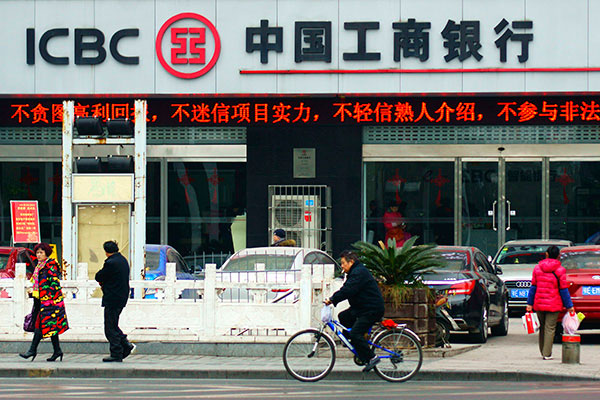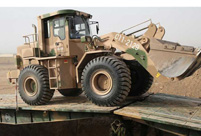


A local branch of ICBC in Yichang, Hubei province. [Photo/China Daily]
Report says six leading banks will take part in trial program
China has restarted nonperforming asset securitization after halting the business in 2009.
Regulators held a meeting last week and confirmed six major commercial banks as the first batch of financial institutions to participate in a trial program for NPA securitization, reported Beijing-based Economic Information Daily on Monday.
The five largest commercial lenders in the country-Industrial and Commercial Bank of China Ltd, China Construction Bank Corp, Agricultural Bank of China Ltd, Bank of China Ltd and Bank of Communications Co Ltd-plus China Merchants Bank Co Ltd, the first shareholding commercial lender wholly owned by corporate legal entities, are reportedly carrying out the trial program.
Reuters reported the regulators set a quota of 50 billion yuan ($7.6 billion) in total on the trial, but according to Economic Information Daily, a newspaper run by Xinhua News Agency, the regulators did not specify a quota for the entire program.
Bank of China is reportedly making the fastest progress among the six banks. It launched NPA securitization last year, submitted its plan on relevant products to the regulators, and is now adjusting its quota on the issuance of bad asset-backed securities according to the regulators' requirement.
Two other major banks also started their own trial and confirmed the lead underwriter recently, the newspaper reported.
None of the six banks replied to China Daily's requests for comment.
Nonperforming loans have been on the rise in China for 17 consecutive quarters, according to statistics from the China Banking Regulatory Commission.
By the end of December, the outstanding NPLs of commercial banks increased by 51 percent year-on-year to 1.27 trillion yuan. During the same period, the NPL ratio went up 42 basis points to 1.67 percent.
Xiao Bo, founder of Zero and One Internet Technologies Co Ltd, a Beijing-based enabler of trading in nonperforming assets, said the huge amount of NPLs may have become a driving force for bad asset securitization.
"If banks continue to sell packages of nonperforming assets at a 70 to 80 percent discount, their financial statements will look bad. But they could transfer rights to earnings from bad loans at a 30 to 40 percent discount through NPA securitization. Although institutional investors in bad asset-backed securities may lose money in a single purchase, they will be compensated by banks in other businesses," he said.
"The regulators also seem to hope that institutional investors will allocate part of social funds to bad asset-backed securities rather than peer-to-peer lending products. This will help prevent companies from going bankrupt due to loan defaults, thus stabilizing the financial system.
"But bad asset securitization will not fundamentally solve the problems related to bad loans, which could only be disposed through means like selling, corporate restructuring and settling with the debtor," he said.
 Engineer troop builds bridge in real combat conditions
Engineer troop builds bridge in real combat conditions You can urinate in public in Chongqing
You can urinate in public in Chongqing Rice terrace scenery in southwest China's Yunnan
Rice terrace scenery in southwest China's Yunnan 2016 Miss Chinatown USA pageant held in San Francisco
2016 Miss Chinatown USA pageant held in San Francisco Ancient pagodas across China
Ancient pagodas across China Wedding dress show up in the air
Wedding dress show up in the air Candidates perform in 2nd examination at Beijing Film Academy
Candidates perform in 2nd examination at Beijing Film Academy Russian photographer brings fairytales to life
Russian photographer brings fairytales to life Chinese beauties, foreign models meet in Chengdu
Chinese beauties, foreign models meet in Chengdu Top 20 hottest women in the world in 2014
Top 20 hottest women in the world in 2014 Top 10 hardest languages to learn
Top 10 hardest languages to learn 10 Chinese female stars with most beautiful faces
10 Chinese female stars with most beautiful faces China’s Top 10 Unique Bridges, Highways and Roads
China’s Top 10 Unique Bridges, Highways and Roads G20 pledges to avoid currency war
G20 pledges to avoid currency war Pro-independence forces rip Taiwan apart
Pro-independence forces rip Taiwan apart China’s ‘fakes fighters’ sue companies over knockoffs
China’s ‘fakes fighters’ sue companies over knockoffs Net watchdog closes tycoon’s social media accounts
Net watchdog closes tycoon’s social media accountsDay|Week